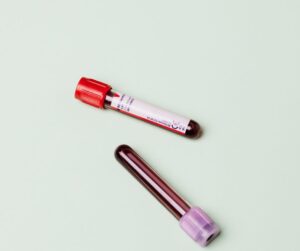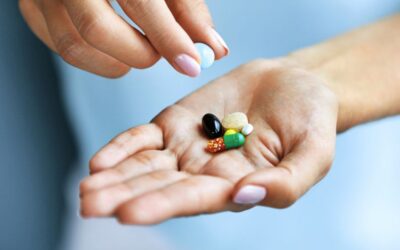September always brings a whisper of new beginnings. The shift in light, the cooler mornings, the steady rhythm of routine returning. But as the pace picks up, many of us are left wondering, why do I still feel so flat?
If you’re navigating tiredness, low mood, poor sleep, or aches and pains, there’s one simple nutrient that could be quietly playing a big role:
Vitamin D.
And now, early autumn, is the perfect time to test your levels.
Why Vitamin D Matters (Far More Than You Might Think)
You might know Vitamin D for its role in bone health, but its impact goes much deeper. Vitamin D influences over 2,000 genes and touches virtually every system in your body, especially those affecting how you feel every day:
- Mood: Low levels have been linked to depression, low mood, and Seasonal Affective Disorder (SAD). In a small RCT, a single high dose of 100,000 IU Vitamin D significantly improved SAD symptoms, outperforming light therapy in all measures¹.
- Energy and Sleep: It supports the immune and nervous systems, influencing both how you respond to stress and how deeply you rest.
- Immune Function: Vitamin D primes immune cells to fight infection and target abnormal cells, including cancer cells.
- Cancer Prevention: A meta-analysis of 70 observational studies found that each 5 nmol/L increase in blood Vitamin D levels was associated with a 6% lower breast cancer risk, across both pre- and postmenopausal women⁴.
- Heart & Bone Health: It plays a key role in calcium metabolism and is crucial for bone strength as we age. Lower Vitamin D levels have been linked to increased osteoarthritis risk and progression².
Many people I see are already supplementing with Vitamin D, but still come back with low test results. Why? They’re simply not taking enough to achieve the therapeutic benefits, or their body isn’t converting it effectively into the active form. There are also other reasons why Vitamin D may be low, despite supplementing, that can be explored.

Can’t I Get It From Food?
Sadly, no, not in meaningful amounts. Vitamin D is found in only a few foods like oily fish, egg yolks, and shiitake mushrooms, but the levels are small. We’re only able to make good levels of Vitamin D in the height of summer. That’s why now is the perfect time to test your levels to see what reserves you have to see you through to next summer.
You’re checking your reserves just as the sunlight starts to fade, a bit like topping up your fuel before a long drive.
Who’s Most at Risk?
- Those who regularly use sunscreen may have reduced Vitamin D production, lab studies show SPF 15 can block up to 99% of UVB rays, but real-world use doesn’t significantly lower vitamin D levels³.
- People with darker skin tones: Higher melanin levels reduce the skin’s ability to produce Vitamin D from sunlight. This means people with darker skin may need 3–5 times more sun exposure to produce the same amount of Vitamin D as someone with lighter skin. As a result, deficiency is more common in Black and South Asian populations, even during summer.
- Those over 50 (our ability to make D declines with age).
- People with fatigue, low mood, insomnia, joint or muscle pain.
- If you’re living with autoimmune issues or low immunity.
- If you’ve been inside a lot during summer (even if you supplement).
“I’ve been in the sun lots this summer… so my Vitamin D levels should be fine, right?”
Not necessarily.
Even with lots of sunshine, several factors may still leave your Vitamin D levels suboptimal:
- Genetics: Certain variants of the VDR gene have been shown to influence how effectively your body responds to Vitamin D supplementation. A 2022 systematic review concluded that these common gene variants can significantly affect Vitamin D status and metabolism⁵.
- Skin tone: As above, more melanin means less Vitamin D production in the same amount of sun.
- Age: Skin becomes less efficient at making Vitamin D with time.
- Sunscreen, clothing, time of day, clouds: All reduce the UVB exposure your skin needs.
Testing trumps guessing every time.
So, Should You Supplement?
Only after testing. Vitamin D is fat-soluble and can build up, so while toxicity is rare, it’s possible. The main reason why I always recommend checking your levels first, is so that you know your starting point. If needed, we can then work out the best way to optimise your levels, which may be taking the right amount of a supplement over a period of time. Taking large doses is not recommended.
Know Your Levels
GPs generally consider 75 nmol/L as optimal, but recent research suggests slightly higher levels may be more beneficial, especially for women with inflammatory or autoimmune profiles.
If your levels are low, a tailored supplementation plan can help. If they’re already in the optimal range, you’ll know what’s working, and what’s not.

Take Action This Autumn
I offer a simple, at-home fingerprick Vitamin D test (just four drops of blood), followed by a one-to-one feedback session to help you interpret the results and plan your next steps to support your health this winter.
👉 Order your test kit and consultation now (£87)
It’s one of the simplest things you can do to support your mood, energy, sleep, and overall wellbeing as autumn settles in.
Don’t wait until the winter slump hits, this is your moment to get ahead.
Footnotes:
¹ Gloth, F. M. III, Alam, W., & Hollis, B. (1999). Vitamin D vs Broad-Spectrum Phototherapy in the Treatment of Seasonal Affective Disorder: A Prospective RCT. Journal of Nutrition, Health and Aging. High doses are NOT recommended.
² Wang, Z. et al. (2023). Serum Vitamin D Levels and Risk of Osteoarthritis Progression: A Meta-Analysis. Arthritis Research & Therapy.
³ Yamshchikov, A. V. et al. (2025). Sunscreen Use and Vitamin D: A Review of Current Evidence. Photodermatology, Photoimmunology & Photomedicine.
⁴ Mohr, S. B. et al. (2014). Meta-analysis of Vitamin D Sufficiency for Improving Survival of Patients with Breast Cancer. Anticancer Research, 34(3), 1163–1166.
⁵ Liu, Y. et al. (2022). Vitamin D Receptor Gene Polymorphisms and Response to Vitamin D Supplementation: A Systematic Review and Meta-Analysis. Nutrients, 14(2), 335.




